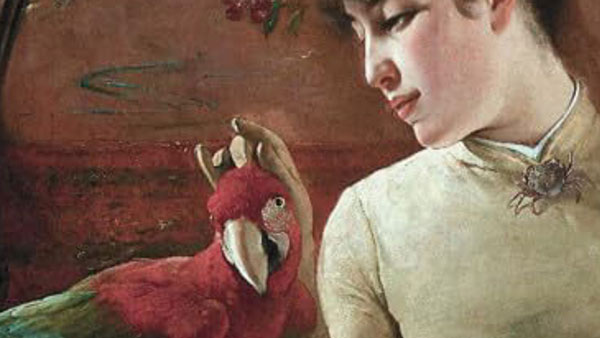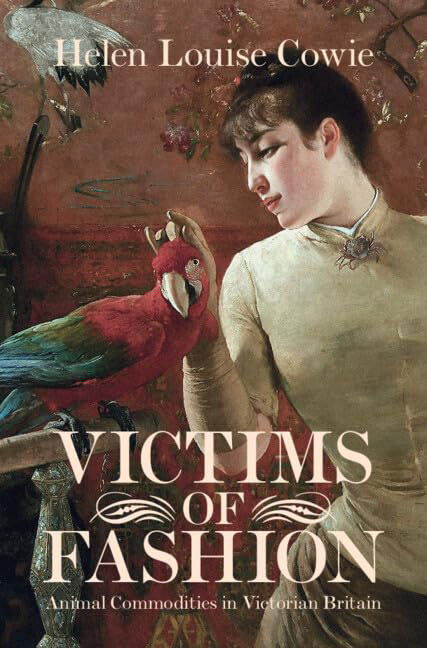Victims of Human Vanity

Victims of Human Vanity: Fashion and the Exploitation of Animals
Review by Carlo Salzani
Victims of Fashion: Animal Commodities in Victorian Britain
by Helene Louise Cowie
Cambridge: Cambridge University Press, 2022

We are all, more or less, fashion victims, following trends and fads and chasing fashionable mirages, occasionally to the point of looking silly. But we humans rarely lose our skin and our life in this pursuit, whereas the skins and lives of nonhuman animals very often constitute the “material” of the pursuit itself. They, nonhuman animals, are the true victims of fashion, as historian Helene Cowie argues in this timely book. Animals, of course, are victims of many human activities, but fashion carries a connotation of frivolity and vanity—that is what the expression “fashion victims” really implies—that adds insult to the injury of exploitation and killing, so that being a victim of fashion seems even worse than being a victim of the food industry (which can claim, at least, to serve a “useful” purpose).
The focus of the book is the long nineteenth century. Humans, of course, have always used animal products for clothing themselves, since the very primal scene of Adam and Eve’s expulsion from the Garden of Eden, when God clothed them with coats of animal skins to hide their shameful nakedness.[1] But the nineteenth century marks a turning point in many regards, all highly significant for our present: a turning point in capitalist development that allowed access to a much broader range and quantity of commodities for a much larger part of the (Western) population; a turning point in Western imperialism that intensified the exploitation of non-Western countries and intertwined the destinies of all countries and continents on earth; a turning point in technological development that allowed a more intense exploitation of nature (a point Cowie particularly emphasizes); and also a turning point in the rising consciousness about the dangers and horrors of this exploitation, paving the way for the twentieth-century ecological and pro-animal movements. The nineteenth century is when the ecological crisis of our present began, and this book therefore reads like an archaeology of today’s Anthropocenic disaster.
In the six chapters of the book, Cowie focuses on six popular animal products: feathers, sealskin, ivory, alpaca wool, perfumes, and exotic pets. These are all “exotic” products, and other animal products such as leather from cows and wool from sheep are not considered—although both cows and sheep are also victims of fashion. However, this focus makes sense as a big part of each chapter is devoted to the environmental and ecological harm the fashion industries have brought about, with particular emphasis on the danger of extinction faced by some species, caused by overhunting and overexploitation, which, of course, does not apply to domesticated species.
The sixth mass extinction we are experiencing today is nothing new and has deep roots, and the exploitation of nature and of many animal species was already unsustainable during the nineteenth century. As insufficient as today were also the measures to contrast or mitigate the damage. This is another sense in which the book reads like an archaeology of our present: the nineteenth-century inability to find a true solution to the problems caused by the overexploitation of nature mirrors our inability (and/or unwillingness) to truly tackle the crisis we are living in and find true solutions, resorting instead, over and over again, to temporary “fixes” that merely postpone the problem or even create new ones.
A poignant example from the book is the fate of African elephants: already at the end of the nineteenth century, they were threatened with extinction because of their coveted ivory, which was used in myriad products; it was, however, not the efforts of conservationists or progressive legislation that saved them, but the invention of plastic (Bakelite was invented in 1907), which could easily and conveniently replace ivory—just like whales, exploited for their fat, were “saved” (more or less) by petroleum. Plastic and petroleum, of course, then went on to cause the environmental problems we are all living with today, and were thus no solution at all.
Another popular attempted solution Cowie describes in detail was that of domesticating the threatened species and acclimatizing them in different territories. Failure and success varied depending on the species (elephants, seals, civet cats, and many species of birds cannot be domesticated, but alpacas and ostriches, for example, proved more amenable), but what these attempts show, once again, is the absurd and doomed logic of shaping and fashioning nature according to human whims. The introduction of alien species into different ecological contexts is what led to today’s myriad and absurd “conservationist” policies centered on eliminating (i.e., killing) “invasive” species in an ecological niche, species that humans themselves introduced in the first place.
Cowie gives due consideration to the many and different attempts to face and at least reduce the impact of the ecological and ethical disasters brought about by the fashion industry, and each chapter tells the story of these attempts as much as that of the sourcing, transportation, and production of the animal commodity in focus. Just like today, many were the reasons and motivations behind these conservationist attempts, from the mere utilitarian desire not to deplete a source of income to ethical considerations focusing on the animals’ suffering and welfare. With the care of a historian, Cowie details all these different positions, the opinions voiced in the press, the economic, social, and national conditions underlying the trade, the attempts to implement conservationist measures, and the problems and outcomes of each attempt. To the eyes of a non-historian like myself, these stories bitterly feel like an eternal repetition of the same, since very similar stories with very similar outcomes (i.e., failure) could be told about today’s victims of fashion. The impression I am left with after reading this book is that nothing has changed, that our problems are the same as those of more than a century ago, and that we are repeating the very same mistakes.
Granted, my pessimism oversteps the “scientific” intentions of the book, a detailed, systematic, and well-researched report on a socio-economic and cultural phenomenon of a determined historical time. The historian today, however, does not need to restrain her emotions, and Cowie’s point of view is clearly evident through the conventions of academic language—not least due to her choice of this specific topic. The epilogue of the book briefly traces the history of the animal species analyzed in the various chapters, taking it beyond the nineteenth century and up to the present. As the last sentence chillingly states, “The age of fashion victims is far from over.”[2] Human vanity keeps exacting deadly sacrifices from the rest of creation and will not stop even when faced with the evident catastrophe we’re living in.
CARLO SALZANI is Research Fellow at the Department of Philosophy of the University of Innsbruck, Austria, guest researcher at the Messerli Research Institute of Vienna, and faculty member of the Paris Institute of Critical Thinking (PICT).
dePICTions volume 4 (2024): Victimhood
[1] Genesis 3:21.
[2] Louise Cowie, Victims of Fashion: Animal Commodities in Victorian Britain, Cambridge: Cambridge University Press, 2022, 264.


Responses